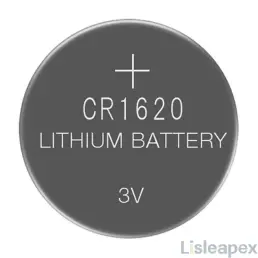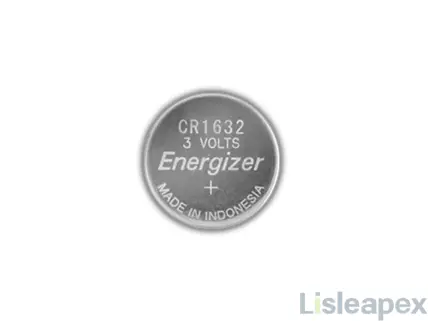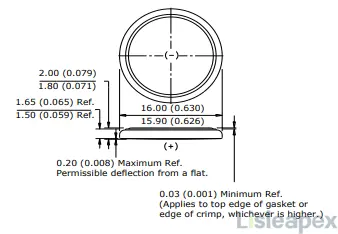When it comes to powering small electronic devices, choosing the right battery can make all the difference in performance and longevity. Among the array of options available, CR1620 and CR1632 batteries stand out as popular choices for their reliability and versatility. These coin-cell batteries offer similar nominal voltages but differ in various aspects such as capacity, dimensions, and applications. Understanding the differences between CR1620 and CR1632 batteries is essential for selecting the optimal power source for your specific needs.
CR1620 Overview
CR1620 batteries are widely used coin-cell batteries known for their versatility and reliability. With a nominal voltage of 3.0V, these batteries are commonly utilized in various electronic devices, including watches, calculators, remote controls, and medical equipment. Featuring a diameter of 16mm and a thickness of 2.0mm, CR1620 batteries offer a balance between compact size and sufficient capacity for powering small devices.

While they are non-rechargeable, CR1620 batteries provide a stable power source with a typical capacity ranging from 75mAh to accommodate diverse energy requirements. Widely available and cost-effective, CR1620 batteries are a popular choice for everyday electronics, offering consistent performance and long shelf life.
CR1632 Overview
CR1632 batteries are another commonly used coin-cell battery option known for their extended capacity and compatibility with various electronic devices. With a nominal voltage of 3.0V, CR1632 batteries provide ample power for applications such as watches, remote controls, key fobs, and medical devices. Featuring a diameter of 16mm and a thicker profile at 3.2mm, CR1632 batteries offer higher capacity compared to CR1620 batteries, typically ranging around 140mAh.

While also non-rechargeable, CR1632 batteries deliver reliable performance and longevity, making them suitable for devices with higher power demands or longer usage periods. Despite their slightly larger size, CR1632 batteries remain widely available and are preferred for their durability and compatibility across a range of electronic gadgets.
CR1620 vs CR1632: Dimensions
CR1620 and CR1632 batteries are both 16mm in diameter, commonly used in small electronic devices such as watches, calculators, and key fobs. However, they differ in thickness, with the CR1620 being 2.0mm thick and the CR1632 being 3.2mm thick. This discrepancy in thickness directly affects their energy capacities, with the CR1632 offering higher energy storage capabilities.
|
Parameter |
CR1620 |
CR1632 |
|
Diameter |
16mm |
16mm |
|
Thickness |
2.0mm |
3.2mm |

CR1620 Dimensions

CR1632 Dimensions
CR1620 vs CR1632: Specifications
|
Parameter |
CR1620 |
CR1632 |
|
Classification |
Lithium Coin |
Lithium Coin |
|
Chemical System |
Lithium/Manganese Dioxide (Li/MnO2) |
Lithium/Manganese Dioxide (Li/MnO2) |
|
Nominal Capacity |
75mAh |
140mAh |
|
Nominal Voltage |
3.0 Volts |
3.0 Volts |
|
Typical Capacity |
81 mAh (to 2.0 volts) |
130 mAh (to 2.0 volts) |
|
(Rated at 21°C) |
(47K ohms) |
(15K ohms) |
|
Typical Weight |
1.3 grams (0.04 oz.) |
1.8 grams (0.06 oz.) |
|
Typical Volume |
0.4 cubic centimeters (0.02 cubic inch) |
0.5 cubic centimeters (0.03 cubic inch) |
|
Max Rev Charge |
1 microampere |
1 microampere |
|
Energy Density |
164 milliwatt hr/g, 573 milliwatt hr/cc |
209 milliwatt hr/g, 754 milliwatt hr/cc |
|
Typical Li Content |
0.043 grams (0.0015 oz.) |
0.036 grams (0.0013 oz.) |
|
Operating Temp |
-30°C to 85°C |
-30°C to 60°C |
|
Self Discharge |
~1% / year |
~1% / year |
CR1620 vs CR1632: Features
- Nominal Voltage: Both batteries provide a nominal voltage of 3V.
- Nominal Capacity: CR1620 offers 120mAh, while CR1632 offers 130mAh.
- Peak Drain Current: Both batteries support a peak drain current of 6.8mA.
- Chemistry: Composed of lithium manganese dioxide cathode and carbon anode.
- Memory Effect: Exhibits a memory effect, mitigated with regular use.
- Lithium-Ion Technology: Utilizes lithium-ion technology for operation.
- Non-Rechargeable: Batteries are non-rechargeable and must be replaced after use.
- Low Self-Discharge: Demonstrates a low self-discharge rate for prolonged shelf life.
- Efficiency: Offers high energy density and output power per gram.
- Stable Voltage: Provides stable voltage output even without external power sources.
- Weight and Dimensions: CR1620 weighs 1 gram with a diameter of 16mm and height of 2mm, while CR1632 weighs 1 gram with a diameter of 16mm and height of 3.2mm.
CR1620 vs CR1632: Application
CR1620 and CR1632 batteries serve distinct roles in powering electronic devices. CR1620 batteries, with their thin design, are commonly employed in compact gadgets such as watches, calculators, fitness equipment, and select medical devices. In contrast, CR1632 batteries, being thicker and offering higher energy output, find applications in devices like car key remote controls, LED lights, small remote controls, and wearable fitness trackers.
CR1620 Applications:
- Watches: Slim wristwatches rely on CR1620 batteries for power.
- Calculators: Compact calculators utilize CR1620 batteries due to their thin design.
- Fitness Equipment: Some fitness trackers and heart rate monitors use CR1620 batteries.
- Medical Devices: Compact thermometers or blood glucose meters may employ CR1620 batteries.
CR1632 Applications:
- Car Key Remote Controls: Automotive key fobs often use CR1632 batteries.
- LED Lights: Small LED lights, such as keychain flashlights, may rely on CR1632 batteries.
- Small Remote Controls: Remote controls for garage door openers or appliances may use CR1632 batteries.
- Wearable Fitness Trackers: Many fitness trackers and smartwatches require CR1632 batteries for power.
CR1620 vs CR1632: Longevity
When considering the longevity of CR1632 and CR1620 batteries, it's crucial to assess their capacity and discharge rates. Although both batteries share similarities in size and voltage, their differing characteristics impact their overall lifespan.
CR1632 batteries boast a higher capacity compared to CR1620 batteries, offering up to twice the longevity. This makes CR1632 batteries ideal for devices with lower power requirements, as they can sustain operation for extended periods without needing replacement.
On the other hand, CR1620 batteries feature a higher discharge rate, making them better suited for devices that demand frequent or high-power usage. While their capacity may be lower than CR1632 batteries, their ability to deliver power efficiently ensures reliability in situations where energy demands are substantial.
Ultimately, the choice between CR1632 and CR1620 batteries depends on the specific requirements of the device and its usage patterns. Understanding the differences in capacity and discharge rates allows users to select the most suitable battery to maximize longevity and optimize performance.
CR1620 vs CR1632: Alternatives
When comparing CR1620 and CR1632 batteries, it's essential to consider alternative options available in the market. Here's a detailed overview of the alternatives for each battery type:
CR1632 Alternatives
ECR1632: This is a widely available alternative to the CR1632. ECR1632 batteries offer similar specifications and performance characteristics, making them suitable replacements for devices that originally use CR1632 batteries.
DL1632: DL1632 batteries are another alternative to CR1632 cells. They are manufactured by Duracell and provide comparable performance and compatibility with devices requiring CR1632 batteries.
CR1620 Alternatives
ECR1620: Similar to ECR1632, ECR1620 batteries are alternatives to CR1620 cells. They are readily available and offer compatible specifications, making them suitable replacements for devices requiring CR1620 batteries.
DL1620: DL1620 batteries are manufactured by Duracell and serve as alternatives to CR1620 cells. They provide comparable performance and compatibility with devices requiring CR1620 batteries.
5009LC: This designation refers to an alternative battery type specified by ANSI and IEC, commonly used as a replacement for CR1620 batteries. It offers similar specifications and performance characteristics.
SBT-17: SBT-17 batteries are another alternative to CR1620 cells. While less common, they provide compatible specifications and can be used as replacements in devices that originally use CR1620 batteries.
These alternatives ensure that consumers have options when sourcing replacement batteries for their devices, providing flexibility and availability across various brands and manufacturers.
CR1620 vs CR1632: Similarities and Differences
When comparing CR1620 and CR1632 batteries, it's essential to understand both their similarities and differences to make an informed choice for your electronic devices.
Similarities:
- Nominal Voltage: Both CR1620 and CR1632 batteries share the same nominal voltage of 3V, ensuring compatibility with a wide range of devices.
- Chemical Composition: Both batteries utilize lithium-based chemistry, albeit with different compositions. CR1632 contains Lithium Manganese dioxide, while CR1620 contains Lithium iron phosphate.
- Applications: Both batteries are widely used in various electronic gadgets that require coin-type batteries, including watches, calculators, toys, and small appliances.
- Non-Rechargeable: Neither CR1620 nor CR1632 batteries are rechargeable, requiring replacement once their power is depleted.
Differences:
Battery Current Capacity: CR1632 boasts a higher maximum current capacity of 130mAh, while CR1620 can handle up to 68mAh of current, making CR1632 suitable for devices with higher power requirements.
Low Self-Discharge: CR1632 exhibits a lower self-discharge rate compared to CR1620, ensuring longer shelf life and retaining charge even in low-temperature storage conditions.
Weight: While both batteries are lightweight, CR1632 weighs slightly more at 1.8 grams, whereas CR1620 weighs 1.2 grams.
Dimension/Size: Both batteries share the same diameter of 16mm and thickness of 2mm, ensuring compatibility with most devices.
Chemical Composition: Although both batteries use lithium-based chemistry, the specific composition differs, potentially affecting performance in certain applications.
Cost: CR1632 batteries generally cost more than CR1620 batteries, with prices ranging between US$0.60 to US$0.80 for CR1620 and approximately US$0.70 for CR1632. However, actual costs may vary depending on factors such as location and supplier.
Understanding these similarities and differences can help you choose the most suitable battery for your specific electronic devices, considering factors such as power requirements, longevity, and budget constraints.
How to Choose between CR1620 and CR1632
When selecting between CR1620 and CR1632 batteries, it's essential to consider various factors to ensure compatibility and optimal performance for your device. Factors such as power requirements, device compatibility, size constraints, longevity needs, cost considerations, battery availability, and environmental impact play a crucial role in decision-making. Evaluating these factors can help you make an informed choice and select the most suitable battery type for your specific needs.
|
Criteria |
CR1620 Battery |
CR1632 Battery |
|
Nominal Voltage |
3V |
3V |
|
Capacity |
75mAh |
140mAh |
|
Thickness |
2.0mm |
3.2mm |
|
Weight |
1.2 grams |
1.8 grams |
|
Power Requirements |
Lower power demands |
Higher power demands |
|
Longevity |
Shorter battery life |
Longer battery life |
|
Size Constraints |
Thin profile, suitable for compact devices |
Thicker profile, may not fit in all devices |
|
Cost |
Generally lower cost |
May be slightly more expensive |
|
Availability |
Widely available |
Widely available |
|
Environmental Impact |
Non-rechargeable, potential waste |
Non-rechargeable, potential waste |
VL1620 vs BR1620 vs LiR1620 vs ML1620 vs CR1620 Battery
These various battery types - VL1620, BR1620, LiR1620, ML1620, and CR1620 - offer distinct features and are utilized in different scenarios based on their specifications and characteristics.
|
Criteria |
VL1620 Battery |
BR1620 Battery |
LiR1620 Battery |
ML1620 Battery |
CR1620 Battery |
|
Chemistry |
Rechargeable vanadium lithium |
Non-rechargeable carbon-monofluoride lithium |
Rechargeable lithium |
Rechargeable lithium manganese-dioxide |
Lithium manganese dioxide |
|
Nominal Voltage |
3.0V |
2.8-3.0V |
3.6-3.7V |
3.0V |
3.0V |
|
Capacity |
~15mAh |
Varies |
Lower than CR1620 |
Lower than CR1620 |
Varies |
|
Rechargeability |
Rechargeable, requires dedicated charger |
Non-rechargeable |
Rechargeable, multiple recharges |
Rechargeable |
Non-rechargeable |
|
Compatibility |
Directly compatible with CR1620 |
Widely used in specific applications |
May not be supported in all CR1620 devices |
Rarely used due to limitations |
Widely used in various devices |
This table outlines the key differences between VL1620, BR1620, LiR1620, ML1620, and CR1620 batteries, providing insights into their chemistry, nominal voltage, capacity, rechargeability, and compatibility. By comparing these factors, users can make informed decisions based on their specific requirements and application needs.
Manufacturer
Energizer:
Energizer, an iconic American brand established in 1896, has built a solid reputation for providing reliable and long-lasting batteries and power-related products to consumers worldwide. With a rich history of innovation and cutting-edge technology, Energizer has consistently delivered high-quality solutions to meet the diverse needs of consumers across various industries.
The company's CR1620 and CR1632 batteries are crafted with precision engineering and are trusted by millions for their superior performance and durability. Energizer's commitment to sustainability is evident in its efforts to develop eco-friendly battery solutions and promote responsible energy consumption practices, further solidifying its position as a leader in the battery industry.
Panasonic:
Panasonic Corporation, a global powerhouse in electronics and technology, was founded in 1918 in Japan and has since become synonymous with quality and innovation. With a diverse portfolio of products ranging from consumer electronics to industrial solutions, Panasonic has earned the trust and loyalty of customers worldwide.
The company's CR1620 and CR1632 batteries are crafted with meticulous attention to detail and incorporate advanced technology to deliver unmatched reliability and performance. Panasonic's dedication to environmental sustainability is evident in its efforts to develop eco-friendly battery solutions and promote recycling initiatives, showcasing its commitment to creating a better world for future generations.
Datasheet
CR1620 datasheet from Panasonic>>
CR1620 datasheet from Energizer>>
CR1632 datasheet from Panasonic>>
CR1632 datasheet from Energizer>>
Conclusion
In conclusion, whether you opt for the compact profile of the CR1620 or the extended capacity of the CR1632, both batteries offer reliable power solutions for a wide range of electronic devices. By assessing factors such as power requirements, size constraints, and longevity needs, consumers can make informed decisions when choosing between CR1620 and CR1632 batteries.
Additionally, exploring alternative battery options and considering the offerings from reputable manufacturers like Energizer and Panasonic further enhances the selection process, ensuring optimal performance and compatibility for various applications.
FAQ
-
Can I interchange CR1620 and CR1632 batteries in my device?
While both CR1620 and CR1632 batteries share the same diameter of 16mm, the crucial difference lies in their thickness. CR1620 batteries have a thickness of 2.0mm, whereas CR1632 batteries are thicker at 3.2mm. Due to this variation in thickness, swapping these batteries in a device may pose compatibility issues.
-
Which one lasts longer?
Generally, CR1632 batteries have a higher capacity and thus tend to last longer than CR1620 batteries. However, the actual lifespan of the battery depends on various factors such as the device's power consumption, operating conditions, and usage patterns.
-
In which devices are CR1632 batteries commonly used?
CR1632 batteries are commonly used in devices that require slightly higher power or capacity, such as digital thermometers, heart rate monitors, key fobs, car alarm remotes, and small electronic gadgets.
-
In which devices are CR1620 batteries commonly used?
CR1620 batteries are commonly used in small electronic devices such as wristwatches, remote controls, keyless entry systems, glucose meters, and small electronic toys.
Stay updated with Lisleapex by signing up for the newsletter


 Congratulations On Your Successful Submission
Congratulations On Your Successful Submission
 Submission Failure
Submission Failure